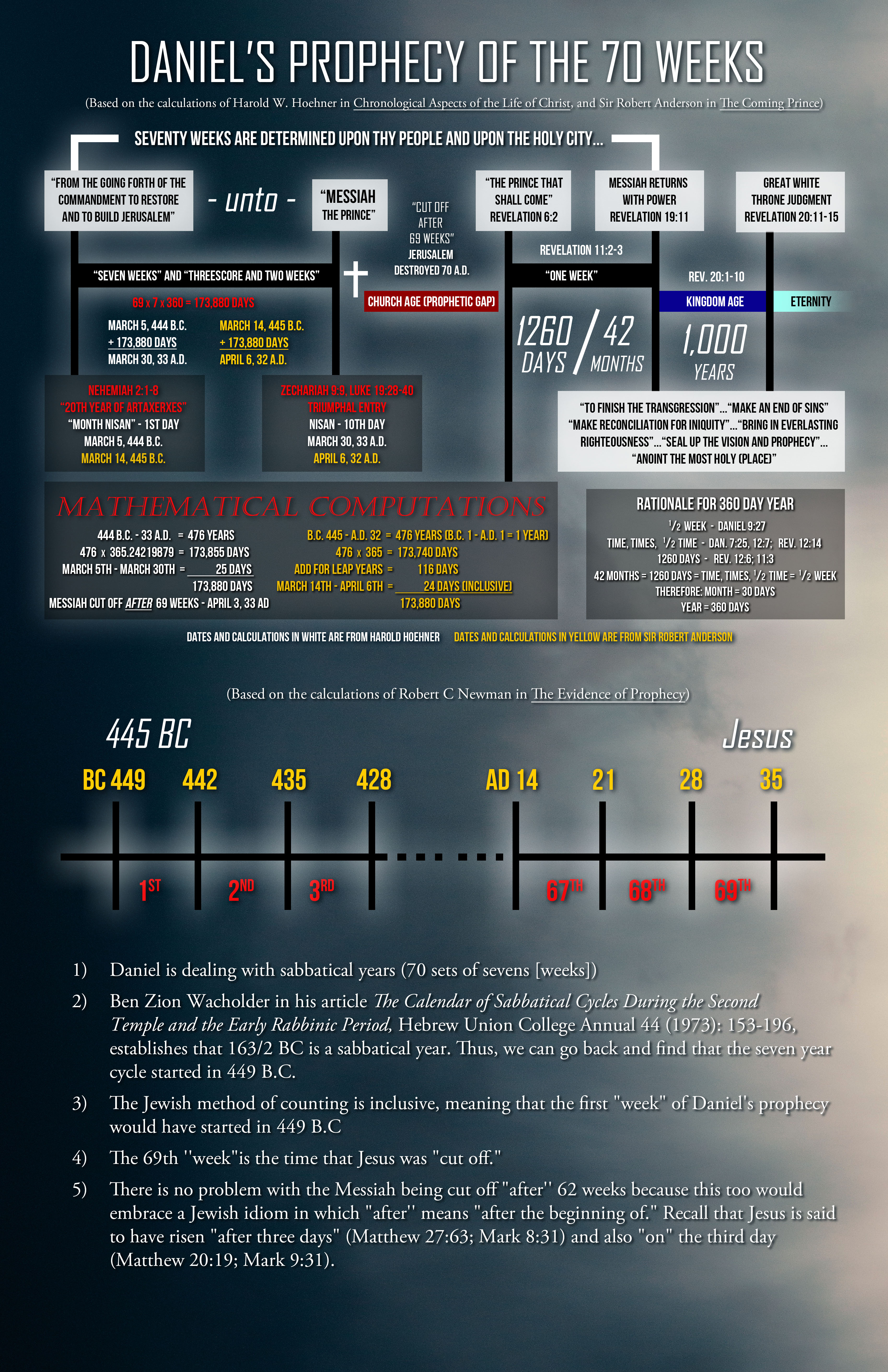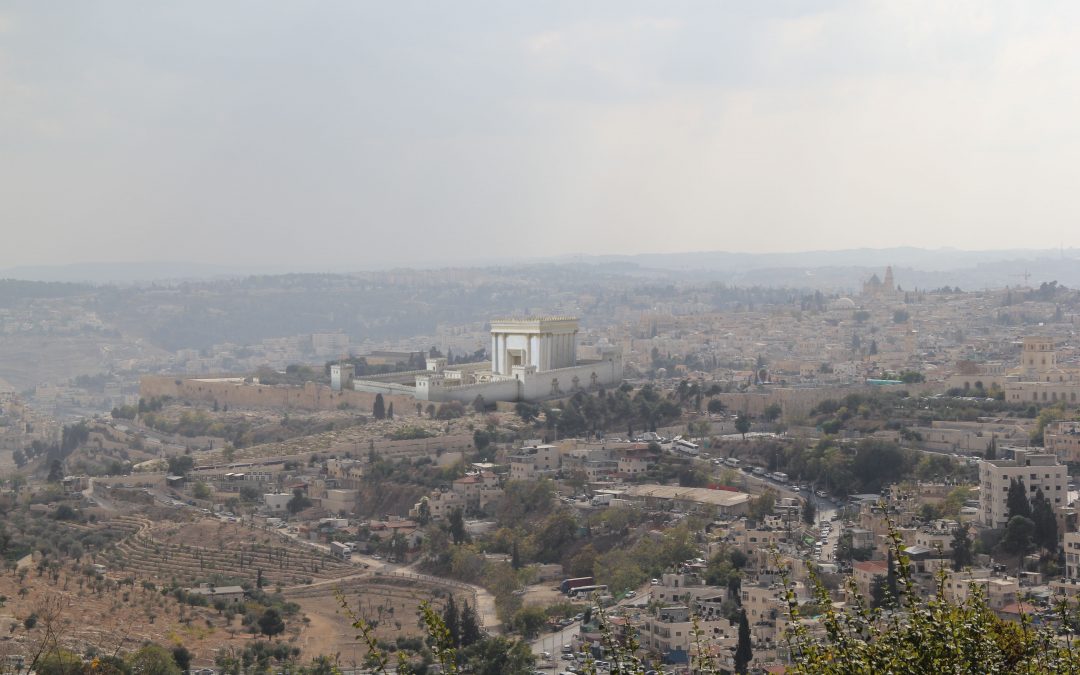By Mark Robinson |
Daniel’s 70 “weeks” prophecy is unsurpassed in majesty, unparalleled in detail, and unrivaled in the prophets. It takes us from the depths of the Babylonian captivity to the grandeur of the Messianic kingdom, providing us with a road map of future events found nowhere else in Scripture. Perhaps the only Messianic prophecy to compare to what is before us is Isaiah’s 53rd chapter where he lays out the life, death, and resurrection of the Messiah. A. C. Gaebelein wrote:
“The prophetic message Gabriel brought from the throne of God to Daniel is perhaps the most important not only in the book of Daniel, but in the whole Bible. The clear understanding of it is indispensable to every reader of God’s Word, who wants to know God’s purposes concerning the future. In the few verses which contain the words of Gabriel, events relating to Jewish future history are predicted. The return of the Jews from the Babylonian captivity, the rebuilding of the city in time of distress, the coming of Christ in humiliation, his death, the destruction of the temple and the city by the Romans, the desolations and wars which were to follow, all this is prewritten in this great prophecy. The final end of the time of the Gentiles, the great eventful week of seven years is revealed in the last verse.”1
The Prophecy – Daniel 9:24-27
24. Seventy weeks are determined upon thy people and upon thy holy city, to finish the transgression, and to make an end of sins, and to make reconciliation for iniquity, and to bring in everlasting righteousness, and to seal up the vision and prophecy, and to anoint the most Holy.
25. Know therefore and understand, that from the going forth of the commandment to restore and to build Jerusalem unto the Messiah the Prince shall be seven weeks, and threescore and two weeks: the street shall be built again, and the wall, even in troublous times.
26. And after threescore and two weeks shall Messiah be cut off, but not for himself: and the people of the prince that shall come shall destroy the city and the sanctuary; and the end thereof shall be with a flood, and unto the end of the war desolations are determined.
27. And he shall confirm the covenant with many for one week: and in the midst of the week he shall cause the sacrifice and the oblation to cease, and for the overspreading of abominations he shall make it desolate, even until the consummation, and that determined shall be poured upon the desolate.
The four verses that contain this prophecy are packed with biblical insight into the future. But the deliverance of this prophecy does not come to us from a void. The background sets the stage for the prophecy.
Daniel was reading the writings of the prophet Jeremiah, Daniel 9:2. Jeremiah had prophesied that the Jewish people would return to Israel after 70 years of Babylonian captivity, Jeremiah 25:11-12; 29:10. Daniel realized that the end of the 70 years in Babylon was at hand. Because of this knowledge, and with complete faith in the God of Israel who knows the future, he prayed one of the most gripping and poignant prayers found in the Bible, Daniel 9:3-19. God answered Daniel’s prayer by sending the angel Gabriel, Daniel 9:20-23, with the prophecy that is known as “Daniel’s 70 Weeks Prophecy” that we read above.
Daniel 9:24
Daniel was likely astounded by what he heard from the angel Gabriel at the beginning of this prophecy – “Seventy weeks are determined upon thy people and upon thy holy city.” “Weeks” is the translation of the Hebrew word “שבוע” shabua.” This word is like the English word “dozen.” Dozen means a set of twelve. Shabua means a set of seven. “Weeks” is a set of seven (days). But, the context of this passage is years. What Daniel is being told is that there is a period of 70 sets (weeks) of 7 years that are coming, a total of 490 years.
The reason Daniel was likely astounded is that he knew from 2nd Chronicles 36:20-21 that Israel had not let the land enjoy her Sabbath rest, Leviticus 25:1-5. The land was to be planted for 6 years and then allowed to rest in the seventh year and God would provide an abundance of food in the 6th year harvest to get them through the seventh year of no crops and the 8th year until the crops were harvested. The 2nd Chronicles passage tells us that God took the Jewish people into Babylonian captivity for 70 years so that “…as long as she lay desolate [the land] she kept sabbath, to fulfil 70 years.”
Israel had not let the land rest for 70 Sabbaths, every 7th year, meaning it was a period of 490 years of disobedience (7 x 70 = 490). Now, Daniel is being told that there is another 490 year period that God has laid out for the Jewish people.
The prophecy is for “thy people and upon thy holy city.” It has to do with the Jewish people and the city of Jerusalem, the holy city. It is important to note that the prophecy is pointedly concerning only the Jewish people, Israel. It has nothing to with the church.
There are 6 things that will be accomplished at the end of this 490 year period. The end of this period is the establishment of the Messianic kingdom, the millennial reign of Jesus. Thus, all six of these things happen at the end of the Tribulation period.
1) Finish the transgression –
The definite article speaks to one specific sin the Jewish people did that they will confess and be forgiven (see Leviticus 26:40 and Hosea 5:14-15). This national sin was the rejection of their Messiah. At the end of the Tribulation period Israel will accept her Messiah (Matthew 23:37-39; Zechariah 12:10; Isaiah 66:7-9; Romans 11:25-27).
2) Make an end of sins –
“make an end of” is tamam khotham and literally means “to close up, to seal, to complete.” The primary idea is of bringing a matter to a conclusion. This will take place when Israel’s sinning will be finished when they get a new heart and new spirit, Jeremiah 31:31-34; Ezekiel 36:24-28; Romans 11:27.
3) Make reconciliation for iniquity –
“make reconciliation for iniquity” is the Hebrew word kaphar and means “to cover, to forgive, to atone, to appease” (see Genesis 6:14 where the word pitch is the word kaphar in both verb and noun form and means “to cover”). This is more than likely a reference to Yom Kippur, the Day of Atonement in Leviticus 16, and speaks of the time when Israel will find national forgiveness at the end of the Tribulation period.
4) Bring in everlasting righteousness –
This will take place with the establishment of the Millennial Kingdom on earth and the rule of Jesus (Isaiah 11:1-9; Jeremiah 23:5-6).
5) Seal up the vision and prophecy –
“Seal up” is the same word as “make an end of” (khotham). The meaning is to bring to a conclusion. Vison and prophecy in regard to Israel will come to conclusion at the end of the Tribulation when it will all be fulfilled and there is no further need of the prophetic gift.
6) Anoint the Most Holy –
This is most likely referring to the rebuilt Temple for the Millennium and its consecrating for service, Zechariah 6:12-13; Ezekiel 40 – 48.
Daniel 9:25
Verse 25 starts with an emphatic “know” and “understand.” “Therefore” is a transitional word, based upon the six promises of verse 24, that what God has promised, most certainly will come to pass. Not only Daniel, but every reader, should be certain, “know,” that what God has promised will come to fruition and we are commanded to “understand” exactly what is going to transpire.
The 490 years of this prophecy will now be broken into three sections. Two of the three are found in this verse – 49 years (“seven weeks” or seven sets of seven) and 434 years (“threescore and two weeks” or 62 sets of seven). The final “week” or seven year period is in verse 27.
The first thing to know is that this 490 year period starts with the “commandment to restore and to build Jerusalem.” Cyrus, king of Persia from 539 – 530 B.C., was the ruler who allowed the Jews to leave Babylon and go back to Jerusalem to rebuild the city and the Temple (Ezra 1-3). A series of events short-circuited this effort and neither the city nor the temple was re-built.
Artaxerxes Longimanus ruled Persia for 40 years (464 – 425 B.C.) and stopped all rebuilding (Ezra 4:23). Later, he would have a change of heart and gave a commission to Ezra to rebuild the Temple (Ezra 7). During the twentieth year of his reign, he noticed the depression of his cupbearer, Nehemiah. Inquiring about his sadness Artaxerxes was told by Nehemiah that his heart was in Jerusalem and he longed for the rebuilding of the city. In 444 B.C. Artaxerxes’ commission to Nehemiah to rebuild the city was given (Nehemiah 2:1-6). The rebuilding of the walls took place in 52 days. Only the commission to Nehemiah actually resulted in the rebuilding of the city wall and thus making Jerusalem fortified or, for ancient purposes, a city again. This, then, is the most likely starting point.
There is one other extremely important promise found in verse 25. From the commandment to rebuild Jerusalem there would be a period of 483 years “unto the Messiah the Prince.” The dating is precise and whenever one wants to date the commandment2 to Nehemiah, from that point, 483 years later Messiah will come!

Daniel 9:26
The verse starts with the sublime statement, “And after threescore and two weeks shall Messiah be cut off.” The 434 years period follows the already passed 49 year period and so we learn that after 483 years from the commandment to Nehemiah Messiah “will be cut off.”
This is one of the most astounding statements in the Scripture. Messiah is not coming to set up a kingdom of peace and prosperity (at least not initially), but He will be destroyed, or killed. And, we are given the time when this will happen!
The works of Sir Robert Anderson and Harold Hoehner, graphically illustrated in the center pages of this issue, show the amazing detail of this prophecy. The fulfillment of the 483 years occurred on the day Jesus rode into Jerusalem on a donkey. The chart illustrating Robert C. Newman’s time line is more general but still pinpoints the time of Messiah being cut off. After the 483 years he was cut off, crucified.
We are also told “the people of the prince that shall come shall destroy the city and the sanctuary.” This gives us an even more general time frame for the Messiah coming and being cut off. The people destroying the city (Jerusalem) and the sanctuary (Temple) were the Romans in 70 A.D. This prophecy definitively identifies the coming of the Messiah to die as having to be BEFORE 70 A.D. Messiah must have arrived prior to 70 A.D. and been killed.
How grateful that God gave other prophecies, such as Isaiah 53, where it told of the Messiah’s death and burial, Isaiah 53:8-9, but also told about His resurrection, Isaiah 53:10. As this verse in Daniel says, He was cut off “not for himself.” He died for the sins of the world.
Time Gap
Before briefly considering the last verse of this amazing prophecy we need to consider the time gaps in this passage.
The first is found in verse 24. We learn that the Messiah would be cut off and following that, the people of the prince, the Romans, would destroy the city and the sanctuary. Jesus died in 33 A.D. and Jerusalem and the Temple were destroyed in 70 A.D. One would not see the almost 40 years of time between the Messiah being cut off and the city of Jerusalem and the Temple’s destruction prior to the actual occurrence of these events. With history as our background, it is clear there is an almost 40 year time gap between these two events.
In the same way, there is a time gap between the end of verse 26 and the beginning of verse 27. The end of verse 26 states “and unto the end of the war desolations are determined.” The war would be the Jewish revolt of 66 – 70 A.D. and the destruction of Jerusalem and the Temple. The desolation was the unknown period of time that Jerusalem and the Temple would lay waste. Presently this time gap is close to 2,000 years.
Daniel 9:27
This verse introduces us to the final week (7 year period) of this 490 year prophecy. We are told, “he shall confirm the covenant with many for one week.” The seven-year period is the coming Tribulation period. “He” is the anti-Christ who will orchestrate a covenant of peace between Israel and her enemies for a seven-year period.
Ron Rhodes comments on the “he” being the anti-Christ: “This verse [Daniel 9:26] prophesies that ‘the city and the sanctuary (Jerusalem and its Temple) will be destroyed by the ‘people of the prince who is to come.’ Who destroyed Jerusalem and its temple in AD 70? Titus and the Roman army. The Roman people are the people of the coming prince, the antichrist. The antichrist will therefore be a Roman.”3
I agree with Ron Rhodes’ conclusion but suggest a slightly different understanding of verse 26 and 27. Along with Rhodes, I see “the people of the prince that shall come shall destroy the city and the sanctuary” being Titus and the Romans destroying Jerusalem and the Temple. It seems to me that the “prince that shall come” speaks of Titus, but is also alluding to the “he” in verse 27, the anti-Christ. The Hebrew word nageed is used for prince and means ruler.
Satan is referred to as the “prince of the power of the air,” Ephesians 2:2; “the prince of this world,” John 12:31, 14:30, 16:11; “the prince of the devils,” Matthew 9:34, 12:24, Mark 3:22. The Greek word archon is used in each of these references and means ruler.
As mentioned earlier, there is a “time gap” between verse 26 and 27 of, presently, about 2,000 years. It is obvious that the “he” of verse 27 can’t be Titus. The “he” of verse 27 finds the “prince that shall come” as the closest antecedent. Presently, Satan is the ruler of the kingdoms of this world, Luke 4:5-6. At the blowing of the 7th Trumpet judgment the kingdoms of this world become Jesus’ at His return, Revelation 11:15.
I believe the best understanding of these verses is that verse 26 speaks of Titus as the “prince” and verse 27 speaks of the anti-Christ as the “prince.” The common thread with both is that they come from the Roman Empire (the anti-Christ from the last days revived Roman Empire) and both are controlled by Satan, the god of the kingdoms of this world. The anti-Christ is much more powerful than any previous ruler because his power is directly from Satan, Revelation 13:5, where other rulers were not directly empowered by Satan as the anti-Christ will be.
Walter K. Price in his book The Coming Antichrist summarizes it this way: “Since it was the Roman army that fulfilled this prophecy in A.D. 70, it implies that the prince himself, the Antichrist, will arise out of a Roman Empire context.”4
In the middle of this 7 year period the Temple has been rebuilt in Jerusalem and sacrifices re-instituted. The anti-Christ goes into the rebuilt Temple and stops the sacrifices and proclaims himself as god – Daniel 8:23-25; 2 Thessalonians 2:3-4; Matthew 24:15; Revelation 13:5.
The seven year period ends with the return of Jesus, the fulfilment of the six promises in verse 24, and the destruction of the anti-Christ and his world kingdom – “even until the consummation, and that determined shall be poured upon the desolate.”
Conclusion
Daniel’s 70 weeks prophecy is a must for students of prophecy. In four short verses we are given an overview, a time line, of prophetic events. A proper understanding of this prophecy establishes the biblical distinction between Israel and the church, a pre-tribulation rapture, Messiah Jesus coming prior to 70 AD to die for our sins, the start of the 7 year Tribulation with a peace agreement orchestrated by the anti-Christ, and the coming Messianic kingdom.
What an amazing prophecy!!!
End Notes
1. A.C. Gaebelein, The Prophet Daniel: A Key to the Visions
and Prophecies, pages 129-30, https://archive.org/details/
prophetdanielkey00gaeb/page/130
2. There are two different dates suggested for the dating of the
commandment to Nehemiah. One is by Sir Robert Anderson
in his classic work The Coming Prince published in 1895. The
other is by Harold Hoehner in his book Chronological Aspects
of the Life of Christ published in 1978. Most people today accept
Hoehner’s time line as being correct. Both time lines are helpful
and similar in many aspects. One other time line has been offered
in the book The Evidence of Prophecy published in 1988 and
edited by Robert C. Newman. Newman contributed the chapter
The Time of the Messiah. Newman’s time line is a more general
time line than Anderson and Hoehner. All these time lines have
been put together in a chart that can be found in the center
page of this issue.
3. Ron Rhodes, New Babylon Rising: The
Emerging End Times World Order, Harvest
House, 2019, pg. 56
4. Walter K. Price, The Coming Antichrist,
Moody Press, 1976, pg. 55

